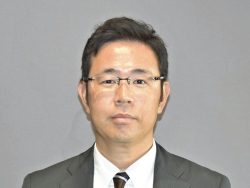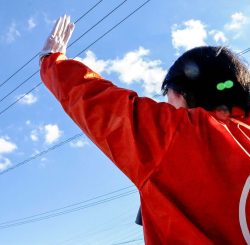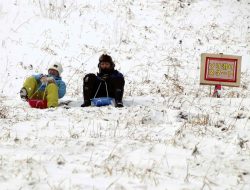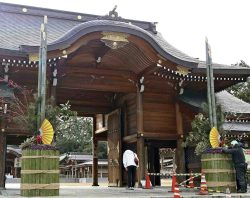Few 2-Horse Races in Japan’s Upcoming Lower House Election; Opposition Parties Fail to Join Forces Against Ruling LDP

The Constitutional Democratic Party of Japan’s headquarters building in Tokyo
6:00 JST, October 17, 2024
Voters are seeing few head-to-head races between ruling and opposition parties in the upcoming House of Representatives election, for which campaigning officially began on Tuesday.
Such two-horse races will effectively take place in only 45 of the 289 single-seat constituencies, down significantly from 132 in the previous election in 2021.
This indicates that opposition parties failed to join forces against the “politics and money”-tainted Liberal Democratic Party. Much attention will be paid to how this affects the race.
“We’ve fielded 237 officially endorsed candidates,” Constitutional Democratic Party of Japan President Yoshihiko Noda told reporters on Tuesday in Hachioji, Tokyo. “We will do our best to achieve a change of government, perhaps on our own.”

In the upcoming election, the ruling coalition of the LDP and Komeito will face off against either CDPJ candidates or candidates effectively fielded jointly by opposition parties in the 45 constituencies.
In the 2021 election, the CDPJ jointly fielded candidates with other opposition parties, including the Japanese Communist Party and the Democratic Party for the People, but ending up losing seats. The effort was mocked by the LDP as a “Constitutional Communist Party.”
Learning from this lesson, Noda made it clear that the CDPJ will not form a coalition government with the JCP, trying to attract moderate conservatives who had left the LDP. He also expressed a negative stance on the immediate abolition of security legislation, the “number one priority” for opposition parties to work together on.
The CDPJ’s attitude prompted fierce opposition from the JCP — which said the conditions to build a united front had been “fundamentally undermined” — and fueled the JCP’s efforts to field candidates. As the result, the CDPJ will battle with the JCP in 142 constituencies, almost triple from the previous 48.
JCP leader Tomoko Tamura told reporters Tuesday in Tokyo, “It’s difficult to cooperate without a certain degree of policy agreement.”
In the end, each opposition party saw the public criticism of the politics and money scandals involving LDP factions as a potential tailwind, and proceeded to actively field candidates on their own.
Watching for an opportunity to become the largest opposition party, the Japan Innovation Party has long indicated its stance of not coordinating candidates with the CDPJ.
There were calls within the DPFP — which like the CDPJ, has its origins in the Democratic Party of Japan — to coordinate candidates with the CDPJ, but talks on basic policies such as energy policy and the Constitution stalled, and the momentum for unification quickly faded. As a result, the CDPJ will face off against the JIP in 115 constituencies, and against the DPFP in 13 constituencies.
Some within the LDP welcome this situation as advantageous, believing the different opposition parties will split their votes.
However, The Yomiuri Shimbun’s nationwide opinion survey conducted on Oct. 1 and 2 showed the approval rating for the Prime Minister Shigeru Ishiba Cabinet was 51%, lower than the approval ratings immediately after the launch of former Prime Minister Fumio Kishida’s Cabinet at 56% and of former Prime Minister Yoshihide Suga’s Cabinet at 74%.
“The honeymoon period is limited, and the difficult situation has not changed,” a junior LDP member said.
"Politics" POPULAR ARTICLE
-

Japanese Language Requirement Eyed for Permanent Residency Status; LDP Plans Revisions of Laws on Foreigners
-
-250x167.jpg)
Japan Eyes Plan to Accept Up To 1.23 Mil. Foreign Workers by End of Fiscal 2028
-

AI-Driven ‘Zero Clicks’ Phenomenon Threatens Democracy; News Outlets Must Be Able to Recover Costs, Stay Independent
-

Japanese Public, Private Sectors to Partner on ¥3 Tril. Project to Develop Domestic AI, SoftBank to Be Key Firm Involved
-

Japan’s Defense Ministry to Extend Reemployment Support for SDF Personnel to Age 65; Move Comes Amid Ongoing Labor Shortage
JN ACCESS RANKING
-

As Chinese Tourists Shun Japan, Hotels and Stores Suffer
-

Core Inflation in Tokyo Slows in December but Stays above BOJ Target
-

BOJ Gov. Ueda: Highly Likely Mechanism for Rising Wages, Prices Will Be Maintained
-

Osaka-Kansai Expo’s Economic Impact Estimated at ¥3.6 Trillion, Takes Actual Visitor Numbers into Account
-

Japan Govt Adopts Measures to Curb Mega Solar Power Plant Projects Amid Environmental Concerns




























